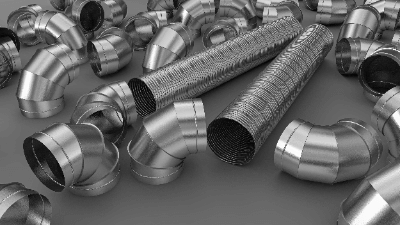What Is a Spiral Duct?

Spiral ducts are inexpensive ducts made by spiraling metal strips, taking advantage of the flexible nature of thin metal. Because spiral ducts are thin and lightweight, they are the most common type of duct used in various parts of buildings and factories.
Other types of ducts include bellows-type flexible ducts and ducts made of plastic such as polyvinyl chloride. Spiral ducts are used for air ducts unless there are special circumstances, as they are lighter and more affordable.
Uses of Spiral Ducts
When cold or warm air is sent to a room for air conditioning, it is sent through spiral ducts. They are also used in air ducts for dust collection and smoke removal. They are often found in the ceilings and walls of buildings and factories.
Zinc steel plates are commonly used for general air conditioning, but spiral ducts made of stainless-steel plates are used where corrosion resistance, weather resistance, and even heat resistance are required.
There are also spiral ducts made of vinyl chloride coated on both sides of a steel plate, which are used in acidic atmospheres and other locations where metal is not resistant to corrosion.
Principle of Spiral Duct
Spiral ducts are made of spiral-rolled metal sheets, with the two ends stacked in a haze-fold formation. The structure of the spiral duct has a reinforcing effect, so even a duct with a thin wall thickness has high strength.
Structure of Spiral Duct
Spiral ducts are made by rounding metal plates to obtain a high degree of roundness and a smooth interior, which reduces the friction of air passing through the duct and allows for efficient airflow.
Straight pipes of spiral ducts can be connected to each other by using fittings and can also be branched in multiple directions by using branches. Spiral ducts of different diameters can also be connected by using special fittings, which can be used to control the air-blowing pressure. Of course, the airflow can also be controlled by installing a regulator.
There are two types of connection methods: plug-in type and flange type. The plug-in type is connected with a plug-in joint, fixed with screws, and sealed with aluminum tape, etc. The flange type can be installed directly on-site. This allows for direct installation on-site and easy fixation and angle adjustment. On the other hand, the flange method provides a stable connection and reproducibility even after connection and disconnection are made. For this reason, the flange method is suitable for high-pressure applications or where components need to be replaced frequently.
Spiral ducts are thin metal plates with high strength, are lightweight, and can be easily fixed to ceilings. Therefore, spiral ducts can be shaped flexibly according to the shape of the building, which speeds up the construction period.
Because of this low cost and ease of use, spiral ducts are used in a variety of locations.